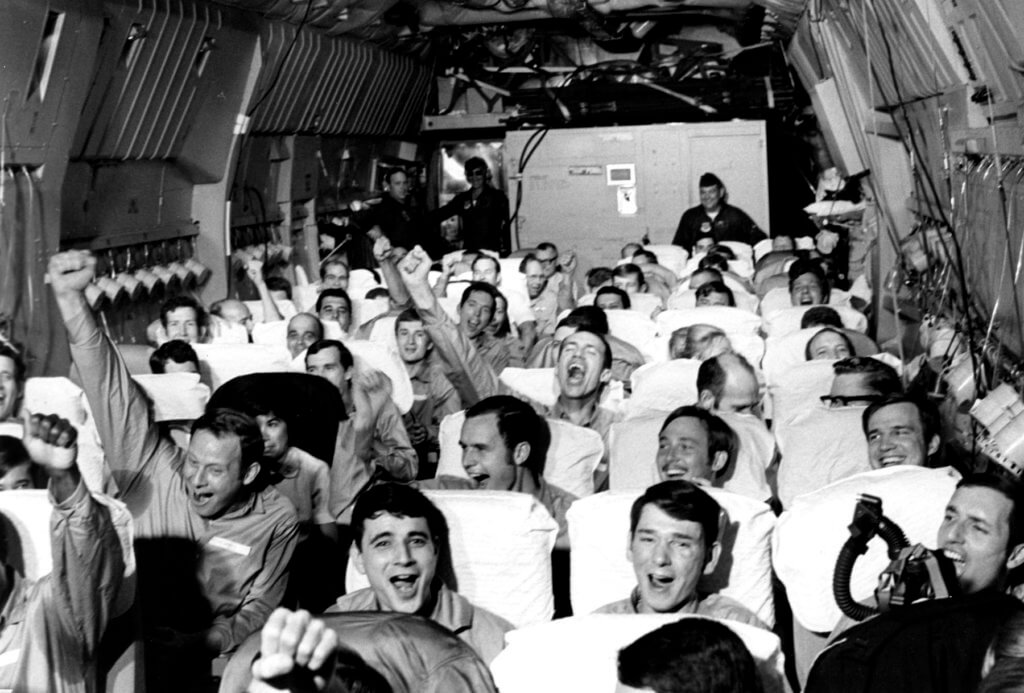Operation Homecoming, which freed now-retired Col. Tom McNish and more than 600 prisoners of war from Vietnam 50 years ago this spring, was the best military operation of McNish’s 34-year career.
“Due to Operation Homecoming and the totally nourishing environment that it put us in immediately after getting out of that situation, we had a hardly noticeable incidence of PTSD,” the 81-year-old said. “All of us, with very rare exceptions, we have had exceptionally successful and good lives since we got home.”
The North Vietnamese shot down McNish’s F-105D Thunderchief on Sept. 4, 1966. Then, they imprisoned him for six-and-a-half years inside the Hanoi Hilton and other POW sites. That’s how he met four National Guardsmen — Col. Bud Day; Maj. Wes Schierman; Brig. Gen. James Robinson “Robbie” Risner; and Col. Larry Guarino.
“Robbie Risner [and] Bud Day were just leaders beyond comparison,” McNish said. “They led with honor, and they led with never asking anybody else to do what they wouldn’t do – and [they’d] do it better.”
Guarino and Schierman also inspired McNish.
RELATED: ‘Beer men of the delta’ represented Army Reserve in Vietnam
“[Guarino] was a fiery, strong Italian; he would give the Vietnamese no quarter no matter what they tried to do to him,” McNish said. “Wes Schierman was such a good man, [a] very solid patriot [who] resisted everything the Vietnamese tried to do to him, even though he was so sick a large part of the time.”
Those four guardsmen, McNish and 657 other POWs were released in March 1973. Two other guardsmen — Col. Richard P. Keirn and Maj. Robert N. Daughtrey — were also rescued 50 years ago.
“When we got to the airport [outside Hanoi], we saw a beautiful C-141 there with an American flag on the tail,” McNish said. “Everyone that was involved in getting us home and taking care of us and getting us back into regular, normal life were emotionally involved in that operation.”
Aeromedical crews from four reserve squadrons assisted with Operation Homecoming after a Military Airlift Command request, according to “The History of the Air Force Reserve for 1972 and 1973.” These crews, including 20 reserve physicians, partnered in the return of released POWs to their homes or U.S. hospitals, the history document stated.
Risner, of Oklahoma; Guarino, of New Jersey; Schierman, of Washington; and Daughtrey, of Texas; deployed to Vietnam with their state Air National Guard unit, according to William B. Boehm, a National Guard Bureau historian. Boehm said that Day, of Iowa, and Keirn, of Ohio, transitioned from the Air National Guard to active-duty Air Force assignments in the 1950s.
All six served on flying missions in Vietnam and their planes were shot down, Boehm said. Daughtrey, Schierman, Guarino, Keirn and Risner were imprisoned from 1965-1973 while Boehm said Day’s captivity lasted from 1967-1973.
Retired Gen. Mark Welsh III, who watched from Colorado as a C-141 full of rescued service members landed at Clark Air Force Base, is still stirred by the sight. Welsh, then a student at the U.S. Air Force Academy, said he thinks healing started as a nation watched Americans limp off the airplanes.
Some had arms so injured that the men couldn’t salute their superiors.
“It was an uplifting thing for the entire nation,” he said of Operation Homecoming. “Seeing families reunited and knowing the suffering those military members had endured to get home and survive that ordeal, I think it just moves people.”
The 50th anniversary of Operation Homecoming offers America an opportunity to heal and be loyal to its soldiers, Welsh said.
“It was one of the few things in those days that brought people who wore uniforms and people who didn’t wear uniforms together,” he said. “The Vietnam War was a very unpopular war with many in the U.S. [Operation Homecoming] was kind of the symbol of the last warriors coming out. It felt like the start of all that stuff calming and the country starting to heal and return to a balance.”
McNish said he and the other POWs thought they were going home when the North Vietnamese gave them civilian clothes instead of prison garb. The crew on the C-141 told the rescued Americans they had a surprise waiting for them.
After they landed at Clark Air Force Base in the Philippines, McNish saw crowds of people with flags and “Welcome Home” signs. Such support, he said, helped him return to the Air Force and finish his dream of becoming a medical doctor.
McNish, now married and living in San Antonio, completed his military career as a command surgeon in the Office of the Air Force Reserve at the Pentagon. He retired July 1, 1994.
“Operation Homecoming was really responsible for that,” he said. “None of us consider ourselves heroes. It was good for us, and it was good for the country that we were treated that way. It was good for the country to have something to wrap its arms around and to feel good about something from the Vietnam War.”
For more information, visit the National Museum of the United States Air Force website.

